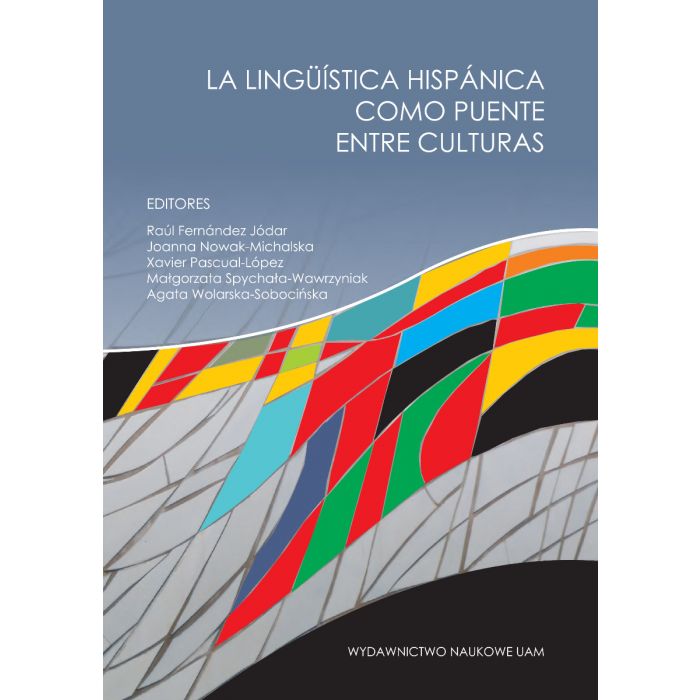La lingüística hispánica como puente entre culturas
- In Stock: out of stock
- ISBN: 978-83-232-4165-2 (PDF)
- DOI: 10.14746/amup.9788323241652
- Category: Open Access, Romance Philology, Linguistics, E-books
- Year of publication: 2022


Znaczenie hispanistyki i językoznawstwa hiszpańskiego w Polsce nie przestaje rosnąć w ostatnich latach, co z kolei powoduje zainteresowanie językoznawców z różnych krajów udziałem w polskich projektach, w celu zaprezentowania wyników swoich badań. Przykładem tego jest ta monografia.
Książka składa się z 17 tekstów (20 autorów), które podzielono na trzy duże bloki: językoznawstwo, dydaktykę i przekład. Dotyczą one konkretnych tematów związanych m.in. z językoznawstwem komputerowym, językoznawstwem stosowanym, językoznawstwem kognitywnym, nauczaniem języka hiszpańskiego jako języka obcego czy tłumaczeniami literackimi lub specjalistycznymi. Wśród autorów znajdują się wielkie nazwiska hiszpańskiego językoznawstwa, jak Rafael Cano Aguilar, który prezentuje ważny rozdział na temat typologii tekstu i organizacji dyskursu w historii języka hiszpańskiego od średniowiecza do Złotego Wieku, czy Tomás Jiménez Juliá, który w swoim rozdziale wyjaśnia ewolucję niektórych zaimków względnych.
Choć większość autorów pochodzi z Hiszpanii i Polski, czytelnik znajdzie tu również rozdziały napisane przez przedstawicieli uczelni z krajów takich jak Tajwan czy Meksyk, co świadczy o tym, że hispanistyka w Polsce jest ważną platformą, umożliwiającą popularyzację własnych osiągnięć naukowych.
Prólogo
SECCIÓN 1: LINGÜÍSTICA
Rafael Cano Aguilar
Tipologías textuales y organización del discurso en la historia del español (de la Edad Media a los Siglos de Oro)
Eva M.ª Domínguez Noya y M.ª Paula Santalla del Río
Excepto, incluso: estructuras no predicativas delimitativas en CSA y otros corpus del español sintácticamente anotados
Óscar García Marchena
Sintaxis y uso de adonde en español oral
Tomás Jiménez Juliá
El que y aquel que. Dos formas relativas diferentes
Xavier Pascual-López
Cambio semántico en los fraseologismos: el caso de echar leña (o aceite) al fuego
Magdalena Sędek
Entre humor y denuncia sociopolítica: hacia una descodificación pragmático-cognitiva de viñetas periodísticas multimodales
Galina Vólkhina y Paola Yunuén Rizo González
Descodificación de los acrónimos del español
Natalia Wiśniewska
Los entrenadores personales en Instagram. El uso de los operadores discursivos en las cuentas de influencers españoles más seguidas
SECCIÓN 2: DIDÁCTICA
Raúl Fernández Jódar
La influencia del proceso de enseñanza/aprendizaje en el reconocimiento y la percepción del registro coloquial
Paulina Nowakowska
El empleo de la dramatización para el fomento del aprendizaje emocional en el aula de ELE
Carla María Míguez Álvarez y Miguel Cuevas Alonso
Comprensión de textos y habilidades lectoras básicas en lengua española. El ciclo medio de Educación Primaria
Małgorzata Spychała-Wawrzyniak
La importancia del enfoque constructivista en el aprendizaje y la enseñanza del español como lengua extranjera desde una perspectiva intercultural
SECCIÓN 3: TRADUCCIÓN
José Antonio Calzón García
Paratextualidad y estrategias pragmáticas en la traducción del Lazarillo. El caso del asturiano
Barbara Galant
Los retos de la traducción infantil, un estudio de casos de la traducción polaca de dos tomos de la serie Manolito Gafotas
Ewa Urbańczyk
Así por esta mi sentencia, lo pronuncio, mando y firmo. Un breve estudio de la repetitividad en la traducción jurídica
Verónica Del Valle Cacela
Reflexiones sobre las necesidades de formación entre el alumnado de traducción jurídica
The importance of Hispanism and Spanish linguistics in Poland has grown unceasingly in recent years, which in turn has led linguists from different countries to show their interest in participating in Polish projects in which they can present the results of their research. An example of this is the monograph.
A total of 20 authors participated in it, and their 17 proposals are divided into three large blocks: linguistics, teaching and translation. They deal with specific topics related to, for example, computational linguistics, applied linguistics, cognitive linguistics, the teaching of Spanish as a foreign language or literary or specialized translations. These authors include eminent names in Spanish linguistics, such as Rafael Cano Aguilar, who presents an important chapter on textual typologies and discourse organization in the history of Spanish from the Middle Ages to the Golden Age, or Tomás Jiménez Juliá, in whose chapter the evolution of certain relative pronouns is elucidated.
Although the majority of the authors hail from Spain and Poland, the reader will also find chapters written by representatives of universities from such countries as Taiwan or Mexico, which is evidence that Hispanism in Poland is an important platform for popularizing their research achievements.
| Detailed information | |
|---|---|
| Prólogo |
Download file

|
| Índice |
Download file

|
|
|
|
| Publication Version | e-book, open access |
| Language | hiszpański |
| Title (EN) | Hispanic linguistics as a bridge between cultures |
| Type of publication | Monografia |
| Edition | I |
| Series | Filologia Romańska nr 86 |
| ISSN | 0554-8187 |
| ISBN | 978-83-232-4165-2 (PDF) |
| DOI | 10.14746/amup.9788323241652 |
| Number of pages | 242 |
| Number of publishing sheets | 15,50 |
